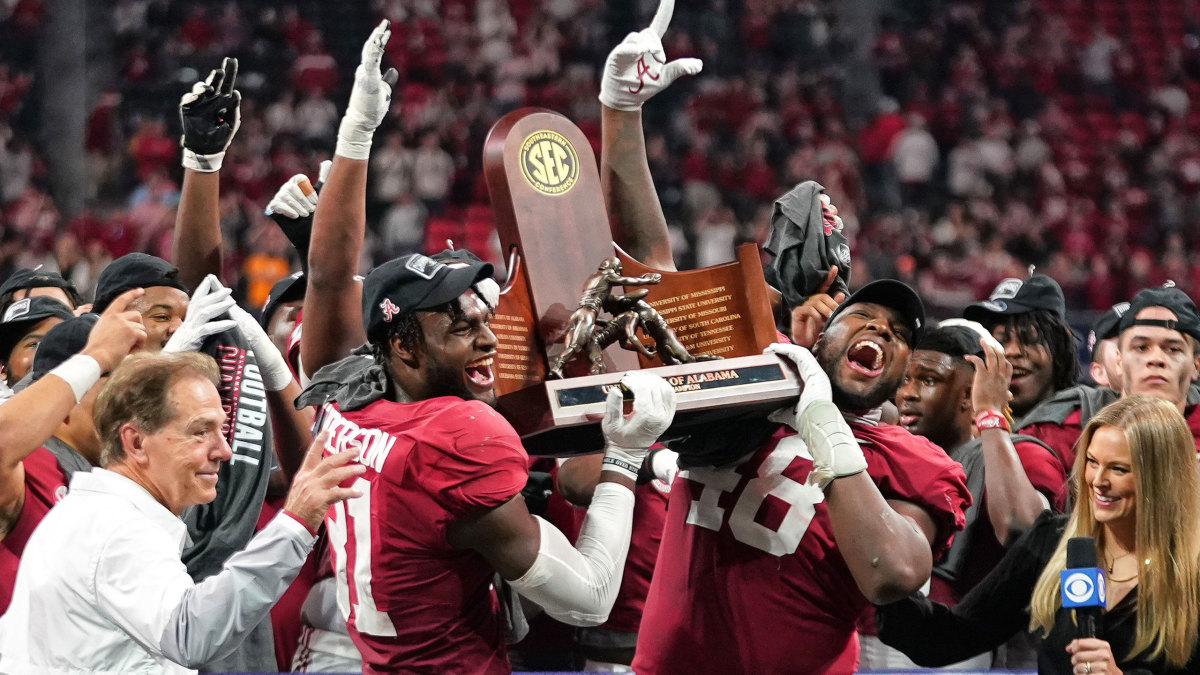Is the SEC’s Playoff Dominance Bad for College Football?

Despite a Group of 5 team crashing the College Football Playoff this year and another program (Michigan) breaking through for its first appearance, college football’s season has come down to a familiar matchup. Five weeks after they played for the SEC title, Alabama and Georgia will battle for a national championship, guaranteeing the conference will take home the trophy for the fifth time in the last seven years.
The Crimson Tide and Bulldogs both easily dispatched their foes in last week’s semifinals, raising more questions about a sport that has been dominated by a handful of teams in recent years and a postseason that faces potential expansion. In this roundtable, Sports Illustrated’s college football writers look at the reasons behind the SEC’s immense Playoff success and discuss its impact on the national landscape.

Is the SEC dominance in the CFP bad for college football? Why?
Ross Dellenger: Unless you’re an SEC diehard, you’d probably say, no, the dominance isn’t good for all of college football. The SEC’s latest run is unparalleled in the history of the sport. The league has qualified 18 teams to the last 16 national championship games and only one of those 16 title bouts didn’t have at least one SEC team in it. The parity within college football—mostly nonexistent historically—is only worsening. How is that better for college football as a whole?
Any sports association, amateur or professional, benefits from healthy and legitimate competition. And for now, one conference is dominating enough to have sent the sport into a somewhat monotonous postseason. Alabama. Clemson. Georgia. Ohio State. Alabama. Clemson. LSU. Alabama. Ohio State. Auburn. Round and round it goes. What happens in years when Ohio State and Clemson are struggling? We have our third all-SEC title game in 11 years.
Pat Forde: It’s clearly not good for a national sport, but it’s also not inherently bad. In other words, this isn’t something that college athletics needs to try to legislate its way out of. (Although I remain open to the idea of further reducing the scholarship limit, from 85 to 80 or 75, which would also help entire athletic departments thrive.) It’s simply up to the rest of the sport to get better, as it was when UCLA was dominating men’s college basketball in the 1960s and early ’70s.
We may never again have outliers like a Colorado–Georgia Tech co-national championship in 1990, but competitiveness that includes every region of the country makes for a far better sport. If the West Coast, Midwest and Northeast are tuning out the title game (or at least pretending they’re tuning out), that’s a drawback. It was great to have new blood in the semifinals in the form of Michigan and Cincinnati, but it also was clear how much more work they have to do to reach a title game.
Richard Johnson: What if it’s actually fine? College football's modern original sin is trying to make this a national enterprise when it became increasingly clear that it was not. If you’re a northerner or a Pac-12 school, then you probably look down on the SEC. If you’re a Big Ten team other than Ohio State, you’re jealous. If you’re Texas or Oklahoma, well, if you can’t beat ’em, join ’em. The best teams, the best coaches, the most money, on and on, all reside in the South and the SEC.

How would the proposed CFP expansion help parity in the sport?
Dellenger: In the end, it might not help parity at all. After watching Georgia dismantle the Big Ten champion and witnessing Alabama dispose of Cincinnati, do you think any other teams aside from the Bulldogs and the Crimson Tide advance to the championship game in a 12-team bracket? If you do, you’re probably in the minority. However, CFP expansion isn’t necessarily about crowning a different champion—it’s about providing more opportunities for all of the FBS. That includes the Group of 5. It took a unique season for Cincinnati to qualify for the CFP this year (three Power 5 champions endured multiple losses, for example, and the Bearcats just happened to have the No. 5-ranked team on their schedule).
Any expanded Playoff is likely to grant some kind of automatic qualifier to the highest-ranked Group of 5 champion, providing more than 60 G5 schools with hope to start the year. Also, the Pac-12 has missed the Playoff for the last five years. An expansion will help its representation. Keep in mind that the FBS championship postseason is representative of about 4% of its total schools. It is, by far, the lowest number of any NCAA sport. Most of them hover around 10–15%, and in basketball, it’s nearly 19%.
Forde: When more teams can sell Playoff appearances in recruiting, it should help disperse the talent pool to more programs. Maybe Georgia and Alabama still end up with a dozen five-star players on the roster at any given time, but if more coaches can go into living rooms and say, “We have made the Playoff, come join us,” it should be a benefit to those programs. To use another basketball comparison: Schools talk about the bump in exposure and recruiting they get from advancing to an NCAA tournament Sweet 16, and this would be similar. Then factor in the ability to host a first-round home game in a 12-team Playoff, with recruits all over the sidelines pregame and in the locker room postgame—unlike a neutral-site bowl that eliminates recruiting—and you have another bonus. Ultimately, the best teams are still going to win, perhaps by the same blowout margins we see now. But more teams involved and more conferences involved will help those currently left out sell their product.
Johnson: I don’t really understand how you plan on getting around this inescapable truth about winning a national championship: Eventually you are going to have to beat a very good team in order to do it. So more often than not, that means you’re going to be playing one of the bushel elites (Georgia, Alabama, Clemson, Ohio State, etc.). The new Playoff may have an upset in the odd year, but it will mostly be a more competitive Playoff in order to get back to the same result we’ve seen—one of the bushel previously referenced is still gonna win. But adding more juice to the bowls and giving more teams a shot on paper is still worth the change.

What do other Power 5 conferences need to do to catch up to the SEC? Which conference has the best chance at doing so, and why?
Dellenger: Let’s dive into why the SEC wins so much before we answer which conference can catch the SEC. It’s really a very simple answer. Excluding the latest cycle, the 11-state SEC footprint has produced 197 five-star prospects since 2011. The other 39 states have churned out 134. The SEC gets the best players, wins the most games, makes the most money and so on. It’s a cycle. But it’s not only the SEC. It is the South in general, where the culture is built more around college sports than any other region of America. Fourteen of the last 15 national champions have come from the Southeast. Those not in the SEC include Florida State and Clemson.
So there’s your answer: Outside of some outliers, programs in the South hold the advantage over anyone else in competing with the SEC. The problem is, those programs have experienced years of irrelevancy. From Miami to Florida State, from Texas to North Carolina, college football needs such programs to reignite their winning ways. There are outliers, of course. The Goliath of the Big Ten, Ohio State, is a force (it is the only non-Southern team to win a title over the last 15 years). Michigan showed this season it has the horses to at least get to the Playoff. If USC and Oregon have the right leader, maybe they can get involved, too. But don’t count on it. The SEC’s stranglehold on college football feels tighter than ever with no sign of loosening.
Forde: Other conferences need to match the SEC imperative, which will be difficult to do. Probably impossible. While the “It Just Means More” slogan is easily mocked, it also carries the weight of truth. When the fans of a program demand competitiveness—the best facilities, the best coaches, the biggest staffs, the biggest NIL packages—they get it. That’s the “problem” most of the Pac-12 currently faces—too well-rounded in terms of athletic perspective, dammit. The Big Ten has the revenue stream, the fan-base size and the general ardor to compete with the SEC; what it doesn’t have is the same geographic talent advantage. There are a lot of good players in the Midwest, and we’ve seen several Big Ten schools make inroads into warm-weather areas for more players as well. But that has to be sustained year-over-year, which is hard to do.
Really, there are specific programs that can catch the SEC more than entire leagues—Clemson and Ohio State lead that pack, with Michigan crashing the scene and Notre Dame TBD, depending on how the coaching change works out. USC has done it before and can do it again, if it improves at the line of scrimmage under Lincoln Riley. Writing this from a long-term view, with Texas and Oklahoma moving on from the Big 12, Baylor could become the new boss of that league, and the newcomers (BYU, Cincinnati, Houston, UCF) all have intriguing potential.
Johnson: It’s not a league thing, because there just isn’t a league that 1-to-14 is going to have the fervor about the sport to continue to push the envelope on competition. It’s always going to be focused on individual brands. Obviously, Ohio State isn’t going anywhere, but USC intrigues me with Lincoln Riley at the helm just because of the sheer might of what USC can be when it’s truly rolling. If you truly have the pick of the litter of half the country and you aren’t directly competing in the southern soup for guys, there’s an opportunity to outflank given the resources the school has and the coach at the helm. But as similarly positioned national outsider Notre Dame has shown, you need speed and a quarterback to truly get over the hump.
More College Football Coverage:
• Can Playoff Expansion Get Over Its Hurdles?
• Used to the Coaching Carousel? Meet the QB Shuffle
• Playoff Semifinals Take Big Ratings Hit
